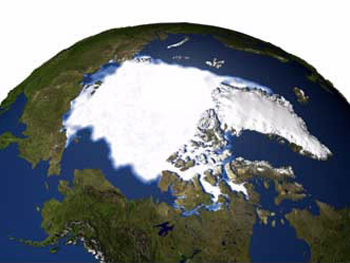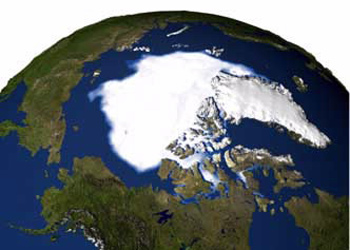Unable to salvage the Arctic phenomenon
The temperature in the Arctic is rising faster than the predictions of the scientific world. Experts believe that melting ice and snow in the Arctic Ocean has reached an irreversible stage.

Ice in the Arctic in 1979. Photo: NASA.

The area covered by the ice decreased significantly in 2005. Photo: NASA.
The ice of the Arctic Ocean is disappearing so fast it is unbelievable. In September 2007, the ice covered only half the area of Europe. According to the National Snow and Ice Data Center's calculations, compared to the period between the 80s and 90s, the Earth lost nearly 40% of the snow and ice. In the summer of 2007, the Bering Strait temperature rose above the average of 5 degrees C. This is the largest gap in history.
The Arctic changes faster than the forecast of global climate models. The state of increasing greenhouse gas emissions cannot explain this phenomenon. A study by US, Norwegian and German scientists has revealed many new things. Experts say the northern circulation of the atmosphere has completely changed in the early decade. Climate change abruptly brings a lot of hot air to the Arctic and is the main driver of climate change happening here.
The research team did not rule out the possibility that the climate in the Arctic region exceeded the limit point so it could not be reversed. Snow ice will melt completely in the summer. An ocean without ice absorbs more sunlight. The temperature of the ocean will increase instead of reflecting the rays when there is a frost covering.
"In the case of the Arctic ice and snow, we have surpassed what is called irreversible points , " US famous climate researcher James Hansen, director of NASA's Goddard Space Research Institute, to speak.
The physicist Rüdiger Gerdes, a member of the research team, thinks that the Arctic snow ice will "disappear quickly if the current climate change model continues to exist". While the Arctic Ocean will remain frozen in winter, the amount of ice formed is too small to survive over the summer.
James Overland, an expert with the US Pacific Ocean and Oceanic Environmental Laboratory (NOAA), said that even when circulation in the Arctic returns to its normal state (currently this statue only appears once every 10 years, this area is still hard to return to its original state
"Every time, we lose so much ice that the Arctic cannot return to its original state. A new era of climate change has begun with great changes in the north pole of Earth , " James said.
- Arctic ice is melting record fast
- Russia explains the phenomenon of the ozone layer in the Arctic
- Unusual weather now originates from the strange phenomenon in the North Pole
- Arctic will melt ice after 5 years
- 7 irreplaceable roles of the Arctic sea ice
- Abnormal melting ice alarm in the Arctic
- Warming in the Arctic will affect Vietnam
- Interesting facts about animals living in the Arctic
- Detects shock under the Arctic ice shelf
- Thousands of snowballs appeared on the Russian coast
- The inevitable phenomenon of warming in the Arctic
- Ice in the Arctic down to a record low
 Is the magnetic North Pole shift dangerous to humanity?
Is the magnetic North Pole shift dangerous to humanity? Washington legalizes the recycling of human bodies into fertilizer
Washington legalizes the recycling of human bodies into fertilizer Lightning stone - the mysterious guest
Lightning stone - the mysterious guest Stunned by the mysterious sunset, strange appearance
Stunned by the mysterious sunset, strange appearance Plan to build giant canopy over Antarctica has problems
Plan to build giant canopy over Antarctica has problems  Why does ice stick to your hands when you hold it?
Why does ice stick to your hands when you hold it?  NASA releases ice map on Mars
NASA releases ice map on Mars  After 389 days in the Arctic, costing more than $160 million, hundreds of scientists brought back bad news: What was it?
After 389 days in the Arctic, costing more than $160 million, hundreds of scientists brought back bad news: What was it?  650,000-year-old 'gateway to the underworld' discovered in Siberia
650,000-year-old 'gateway to the underworld' discovered in Siberia  How to explain the strange ice circle that rotates like a time-travel door?
How to explain the strange ice circle that rotates like a time-travel door? 